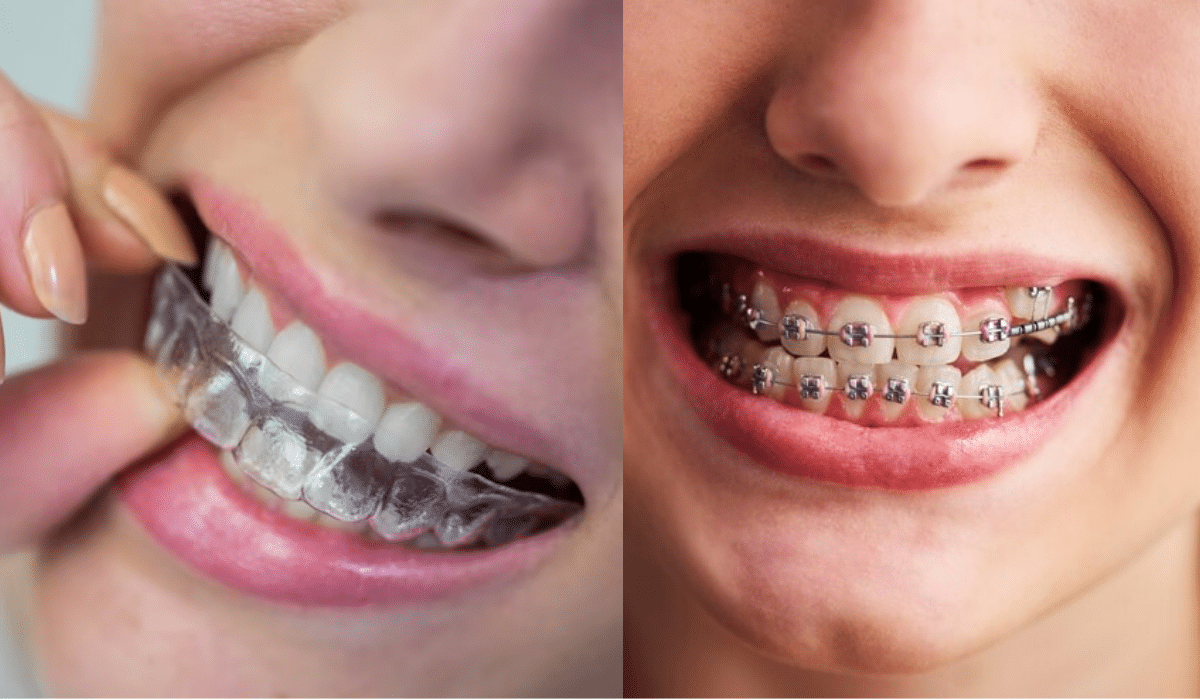Are you dreaming of a dazzling smile but dreading the thought of metal brackets and wires? You’re not alone. Millions of individuals, both teens and adults, are looking for effective yet discreet ways to straighten their teeth. This is where the two leading orthodontic contenders, clear aligners and traditional braces, enter the scene. Both options promise a straighter smile, but they differ significantly in terms of aesthetics, comfort, and treatment process. So, which one reigns supreme? The answer, like most things in life, isn’t a complex one. It depends on your individual needs, preferences, and lifestyle. This blog delves into the world of clear aligners and traditional braces, providing a comprehensive overview of their pros and cons to help you navigate the decision-making process with confidence.
The Wonders of Clear Aligners
Clear aligners, also known as invisible braces, are taking the orthodontic world by storm. These custom-made, removable trays are crafted from clear, high-tech plastic that gently shifts your teeth into their desired positions. Here’s a glimpse into the key advantages of clear aligners:
Discreet Design
Unlike traditional braces, clear aligners are virtually invisible. As a result, it makes them a perfect choice for individuals who are self-conscious about the aesthetics of orthodontic treatment. You can confidently smile and laugh without worrying about metal brackets drawing unwanted attention.
Enhanced Comfort
Clear aligners are known for their smooth, comfortable wear compared to traditional braces. They eliminate the irritation caused by metal brackets and wires rubbing against your cheeks and lips, making the entire treatment process more tolerable.
Improved Oral Hygiene
Maintaining good oral hygiene is crucial during orthodontic treatment. Since clear aligners are removable, you can easily brush and floss your teeth without any obstacles. Doing so ensures optimal oral health throughout the process.
Dietary Freedom
Unlike traditional braces, clear aligners allow you to enjoy your favorite foods without restrictions. Remove the aligners before eating and replace them afterward. This eliminates the worry about food getting stuck in wires and brackets.
Demystifying Traditional Braces: The Tried-and-Tested Option
Traditional braces, also known as metal braces, have been the gold standard in orthodontic treatment for decades. They consist of metal brackets bonded to your teeth, connected by wires that exert gentle pressure to move your teeth into their desired positions. Here’s a breakdown of the notable advantages of traditional braces:
Proven Effectiveness: Traditional braces have a long and successful track record of correcting a wide range of orthodontic issues, from mild to complex cases. They offer precise control over tooth movement, making them a reliable option for achieving predictable results.
Cost-Effectiveness: In some cases, traditional braces may be a more cost-effective option compared to clear aligners. However, it’s important to consult with your orthodontist to understand the individual costs associated with each treatment plan.
Suitable for All Ages: Traditional braces can be used effectively for both children and adults, making them a versatile option for patients of all ages.
Making the Perfect Choice: Factors to Consider
Now that you’re familiar with the key features of both clear aligners and traditional braces, it’s time to ponder the factors that will influence your decision:
The severity of the Orthodontic Issue: Clear aligners are typically recommended for mild to moderate cases of teeth misalignment or crowding. For complex cases involving significant jaw discrepancies or rotations, traditional braces may offer more precise control and predictability.
Lifestyle and Compliance: Clear aligners require a high level of compliance, as you need to wear them for at least 22 hours a day. If you struggle with maintaining a consistent routine, traditional braces might be a better choice. It’s because they’re fixed and require adjustments by your orthodontist.
Personal Preferences: Consider your aesthetic preferences and comfort level. If you prioritize discretion and comfort, clear aligners might be a better fit. However, if cost or the need for precise control is a major concern, traditional braces might be the preferred option.
Consultation is Key: Regardless of your initial preferences, scheduling a consultation with a qualified orthodontist is crucial. They will assess your individual needs, perform a thorough examination, and recommend the best course of treatment based on your specific situation.
Choosing between clear aligners and traditional braces hinges on your individual priorities and orthodontic needs. While both effectively straighten teeth, they offer distinct advantages and disadvantages. However, for complex corrections or growing patients, traditional braces provide more precise control and may be the preferable option. Ultimately, consulting a qualified orthodontist is crucial. They can assess your specific situation, discuss your preferences, and recommend the most suitable treatment plan to achieve your desired smile and oral health goals.




